In part one of this article I showed you how a half-blind router dovetail jig works, and how to size your drawer parts for routing in the jig. In this final installment, I will explain using the jig to rout the joints, and then how to assemble the drawers.
Boards must be correctly oriented and clamped in the jig so both halves of the joint are cut at the same time. Insides always face out. There are three options for orienting the boards in the jig. Each orientation has its advantages.

 The most common way to orient the drawer parts in the dovetail jig is top edges out. The left side of the jig is used to rout the front right and left rear corners of the drawer, and the right side of the jig is used to rout the front left and right rear corners of the drawer. This orientation ensures that the top edges of the drawer parts align flush even if the parts are slightly different widths.
The most common way to orient the drawer parts in the dovetail jig is top edges out. The left side of the jig is used to rout the front right and left rear corners of the drawer, and the right side of the jig is used to rout the front left and right rear corners of the drawer. This orientation ensures that the top edges of the drawer parts align flush even if the parts are slightly different widths.
 A simpler way to orient the drawer parts is either top or bottom edges out, and then only one side of the jig is used. I find this is the easiest way to use the jig. The widths of the drawer parts must all be exactly the same, and then the top edges will align flush.
A simpler way to orient the drawer parts is either top or bottom edges out, and then only one side of the jig is used. I find this is the easiest way to use the jig. The widths of the drawer parts must all be exactly the same, and then the top edges will align flush.
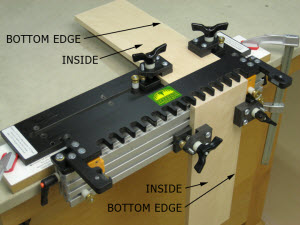 Bottom edge out orientation and both sides of the jig are used when making undermount slide drawers. The jig's stops are moved outward so a wider bottom pin is made which allows for the required 1/2" space underneath (see Routed Half-Blind Dovetail Drawers - Part 1). The right side of the jig is used to rout the front right and left rear corners of the drawer, and the left side of the jig is used to rout the front left and right rear corners of the drawer.
Bottom edge out orientation and both sides of the jig are used when making undermount slide drawers. The jig's stops are moved outward so a wider bottom pin is made which allows for the required 1/2" space underneath (see Routed Half-Blind Dovetail Drawers - Part 1). The right side of the jig is used to rout the front right and left rear corners of the drawer, and the left side of the jig is used to rout the front left and right rear corners of the drawer.
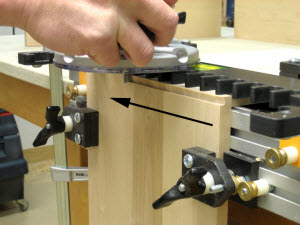 Start the joint routing with a scoring cut. Make sure your dovetail router bit height is correct so your joint fits well. Rout from the right end to left end. This is called "climb cutting", and it's basically routing backwards. Doing so removes a small amount of wood leaving no tearout. This is a very important step in achieving a good looking dovetail joint.
Start the joint routing with a scoring cut. Make sure your dovetail router bit height is correct so your joint fits well. Rout from the right end to left end. This is called "climb cutting", and it's basically routing backwards. Doing so removes a small amount of wood leaving no tearout. This is a very important step in achieving a good looking dovetail joint.
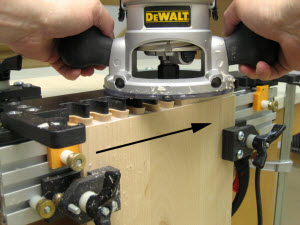 Finish routing the dovetail joints by moving the router from the left end to the right end, and guiding the bit in and out of the template fingers. Be sure to hold the router base tight to the template so the router doesn't tip forward.
Finish routing the dovetail joints by moving the router from the left end to the right end, and guiding the bit in and out of the template fingers. Be sure to hold the router base tight to the template so the router doesn't tip forward.
 Cut the groove for the drawer bottom using a table saw with a hold down. A flat top grind saw blade ensures a flat bottom on the groove. Cut the groove so it's inside the bottom dovetail socket/tail joint. Make two passes to widen the groove so its width matches the thickness of your drawer bottom. Cut the drawer back to its finished width based on where the bottom groove lands. Instead of two passes on a single saw blade you could do one pass on a dado head set to the thickness of your bottom.
Cut the groove for the drawer bottom using a table saw with a hold down. A flat top grind saw blade ensures a flat bottom on the groove. Cut the groove so it's inside the bottom dovetail socket/tail joint. Make two passes to widen the groove so its width matches the thickness of your drawer bottom. Cut the drawer back to its finished width based on where the bottom groove lands. Instead of two passes on a single saw blade you could do one pass on a dado head set to the thickness of your bottom.
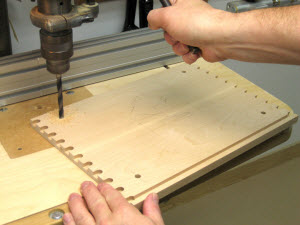 Bore 5/16" dia. holes for washer head screws used to attach the drawer faces to the drawer fronts. Place the holes close to the corners, but leave enough room to drive the screws later after the drawers are assembled.
Bore 5/16" dia. holes for washer head screws used to attach the drawer faces to the drawer fronts. Place the holes close to the corners, but leave enough room to drive the screws later after the drawers are assembled.
 Finish sand the insides of the drawers. Do not sand between the dovetail sockets. You don't want to alter the shape of those edges and ruin the fit of the dovetail joint.
Finish sand the insides of the drawers. Do not sand between the dovetail sockets. You don't want to alter the shape of those edges and ruin the fit of the dovetail joint.
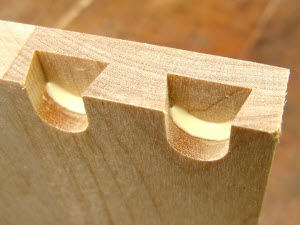 Dovetail joints require less glue than you might think. Apply a small bead of glue like this in each socket, but don't apply glue to the tails. Any more glue than this and you'll have a mess to clean up.
Dovetail joints require less glue than you might think. Apply a small bead of glue like this in each socket, but don't apply glue to the tails. Any more glue than this and you'll have a mess to clean up.
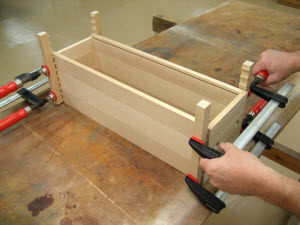 Glue and clamp the drawer together. Notched clamping blocks are used to apply pressure to the joints and ensure the tails seat completely in the sockets.
Glue and clamp the drawer together. Notched clamping blocks are used to apply pressure to the joints and ensure the tails seat completely in the sockets.
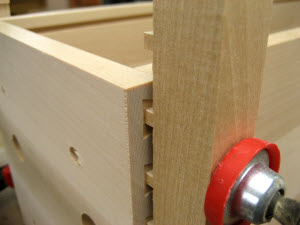 The fingers of the notched clamping blocks apply pressure only to the tails. Use hardwood to make your clamping blocks, and space the fingers based on your dovetail jig's dovetail spacing.
The fingers of the notched clamping blocks apply pressure only to the tails. Use hardwood to make your clamping blocks, and space the fingers based on your dovetail jig's dovetail spacing.
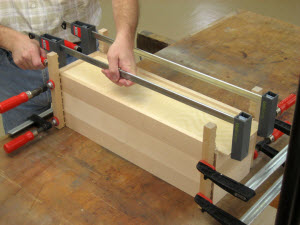 The drawer bottom is made 1" wider initially, and it's used to square the drawer as the glue dries. That extra 1" gives you something to grab so the bottom can be easily removed after the glue dries.
The drawer bottom is made 1" wider initially, and it's used to square the drawer as the glue dries. That extra 1" gives you something to grab so the bottom can be easily removed after the glue dries.
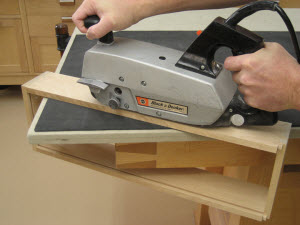 Use a belt sander to sand the protruding pinboard ends flush with the drawer sides, then finish sand the drawer sides, top edges, and drawer bottom, and ease any sharp edges.
Use a belt sander to sand the protruding pinboard ends flush with the drawer sides, then finish sand the drawer sides, top edges, and drawer bottom, and ease any sharp edges.
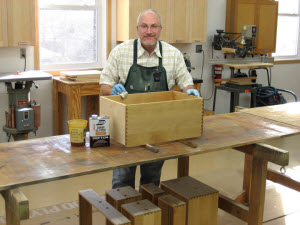 Apply your favorite finish. I use one coat of Danish oil. It's fast, effective, and looks great. Some folks just leave their drawers unfinished. That's okay too.
Apply your favorite finish. I use one coat of Danish oil. It's fast, effective, and looks great. Some folks just leave their drawers unfinished. That's okay too.
Part 2 wrap-up.
That's it! Now you know all my tricks, and with a little practice you'll be making dovetail drawers with ease.
Photos By Author
Related Video:


Thanks a lot, I just pulled out my old Woodhaven 7500 jig, read the instructions, and thought "crap this thing is soooo complicated" your explanation explained what I needed to know, with great clarity. Woodhaven produces good products, but their documentation sucks.
Very clear instructions I can't wait to try,thank you, Jack Johnston